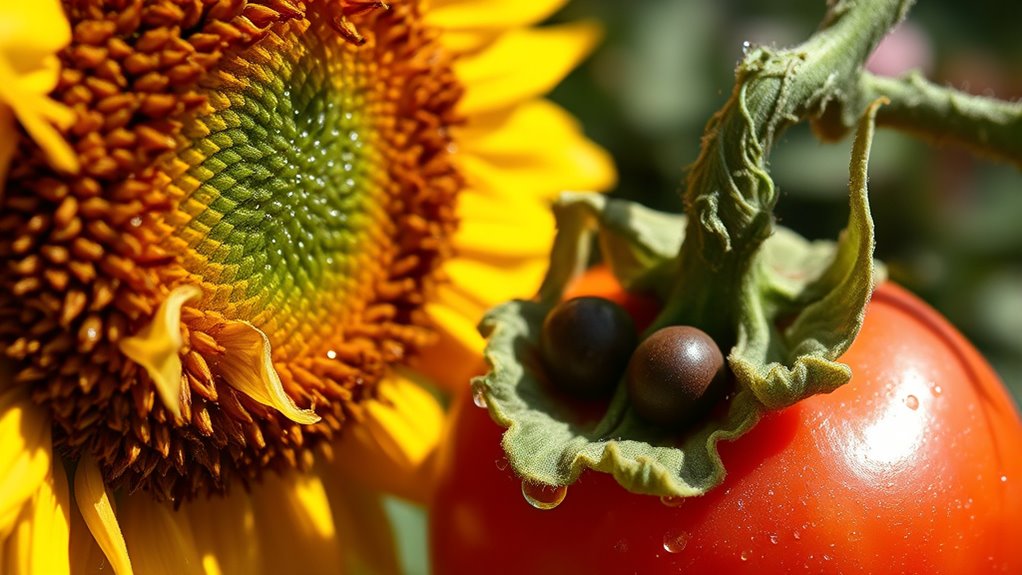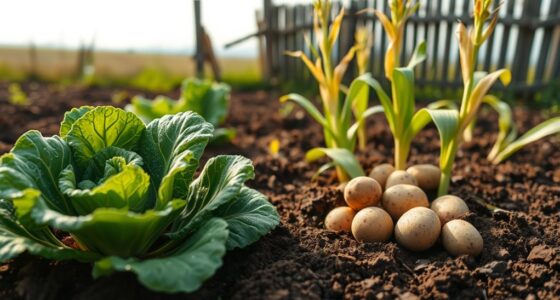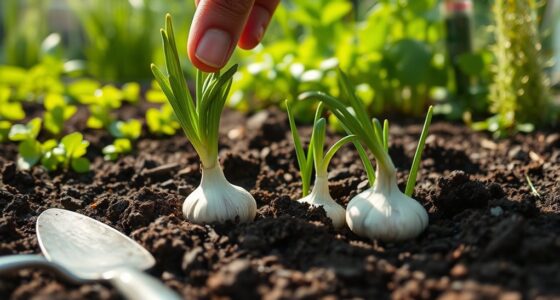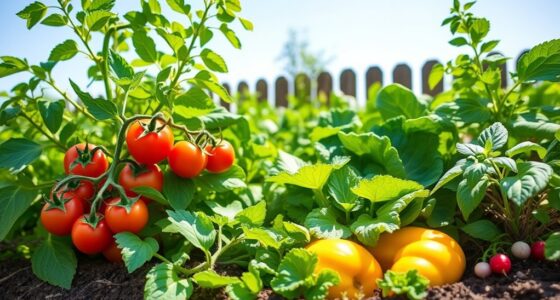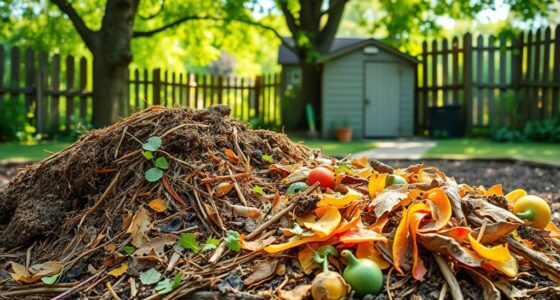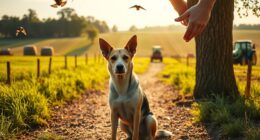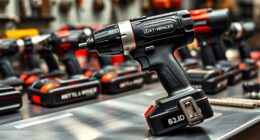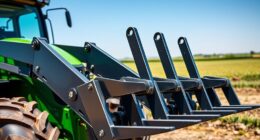To save seeds from your garden plants, focus on open-pollinated or heirloom varieties that produce true seeds. Harvest seeds when the seed heads are fully mature, dry, and brown, then carefully remove any debris. Dry seeds thoroughly in a cool, dry place before storing them in labeled airtight containers kept in a cool, dark spot. Regularly check your stored seeds for mold or pests. Keep learning to guarantee successful seed saving across seasons.
Key Takeaways
- Choose open-pollinated or heirloom plants for reliable seed saving and avoid hybrids.
- Harvest seeds when seed heads are fully mature, dry, and brown for best results.
- Clean and thoroughly dry seeds in a cool, dry, well-ventilated area before storage.
- Store seeds in airtight containers labeled clearly, in a cool, dark, and consistent environment.
- Regularly check stored seeds for mold or pests to maintain seed viability over time.
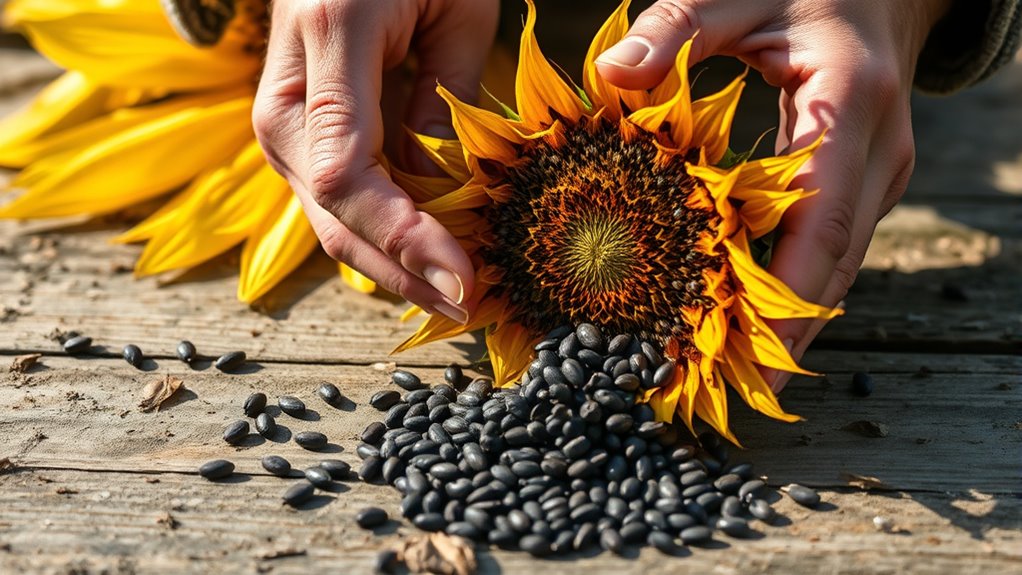
Have you ever wondered how to preserve the best traits of your favorite garden plants? Saving seeds is a simple yet effective way to do just that, allowing you to continue growing the plants you love year after year. When you save seeds properly, you’re engaging in plant propagation, which is the process of reproducing plants from seeds. This not only saves you money but also helps maintain the unique characteristics of your garden plants. But knowing how to handle seed storage is essential to guarantee your saved seeds stay viable and healthy until planting time.
First, you need to identify the right plants for seed saving. Not all plants produce true seeds—some hybrid varieties may not come back true to type, meaning their offspring could look different from the parent plant. Focus on open-pollinated or heirloom varieties, as these tend to produce reliable seeds that reflect your plant’s traits. When your plants flower and produce seed heads, wait until the seeds are fully mature before harvesting. This usually means waiting until the seed heads turn brown or dry out, indicating they’re ripe.
Choose open-pollinated or heirloom plants for reliable seed saving and true-to-type results.
Once you harvest your seeds, proper seed storage becomes essential. Clean the seeds thoroughly, removing any plant debris or chaff, which can harbor mold or pests. Dry the seeds completely—moisture is the enemy of seed viability—by spreading them out on paper towels or screens in a cool, dry, well-ventilated area. When the seeds are fully dry, store them in airtight containers like glass jars or sealed plastic bags. Label each container clearly with the plant variety and harvest date, so you can keep track of your seed inventory.
Temperature and humidity play important roles in seed longevity. Keep your seed storage containers in a cool, dark place, ideally between 32-41°F (0-5°C). A refrigerator is often a good spot, but avoid storing seeds near fluctuating temperatures or in damp areas. Proper seed storage not only prolongs the life of your seeds but also maintains their germination potential for multiple seasons. It’s a good idea to periodically check your stored seeds for signs of mold or pests, discarding any compromised seeds to prevent contamination.
Frequently Asked Questions
Can I Save Seeds From Hybrid Plants for Next Year?
You can save seeds from hybrid plants, but seed purity might be compromised. Hybrid plants result from plant crossing, which produces unique characteristics. When you save seeds from hybrids, they often won’t grow true to the parent plant and may have unpredictable traits. To guarantee consistent results, it’s best to save seeds from open-pollinated or heirloom varieties. If you do save hybrid seeds, expect variation in your next garden crop.
How Do I Prevent Seed Contamination Between Different Plants?
They say “a chain is only as strong as its weakest link,” and that applies to seed contamination. To prevent cross contamination, you should use seed isolation techniques like physical barriers, isolation distances, or bagging flowers. These methods help maintain seed purity and prevent unwanted pollination. By practicing proper cross contamination prevention, you guarantee your seed harvest remains true to the parent plants, giving you healthy, predictable plants next season.
What’s the Best Storage Method to Maintain Seed Viability?
You should use airtight seed storage containers to keep seeds dry and protected from pests. Before storing, make certain you follow proper seed drying techniques—spread seeds out in a cool, dark area until fully dried. Label your containers clearly, and store them in a cool, dark, and stable environment like a basement or refrigerator. This approach helps maintain seed viability, ensuring your seeds stay healthy for planting seasons ahead.
How Do I Identify When Seeds Are Fully Mature?
Think of seed ripening as nature’s countdown; it’s when your plant’s gift is ready to be shared. You’ll spot seed maturity indicators like color change, dryness, and firmness. For example, sunflower seeds turn from green to black and become hard. When seeds feel dry and firm, and their color has deepened, they’re fully mature and ready for harvest. Trust these clues to guarantee your seeds are at their peak.
Are There Any Legal Restrictions on Saving Seeds From Certain Plants?
You might wonder if there are legal restrictions on saving seeds. Seed patent laws can protect specific plant varieties, meaning you can’t legally save or sell patented seeds without permission. Organic seed regulations encourage saving seeds from organic plants, but some restrictions apply to prevent patent infringement. Always check local laws and seed source labels to guarantee you’re complying. This way, you stay within legal boundaries while saving seeds from your garden plants.
Conclusion
By saving your garden seeds, you’re nurturing a legacy, much like the ancient gardeners who passed down their knowledge through generations. Each seed you save is a promise of future harvests, a silent proof to patience and care. Remember, as the roots beneath the soil hold the promise of new life, so too does your dedication guarantee your garden’s tomorrow. Keep planting, keep dreaming—your garden’s story continues with every seed you save.

